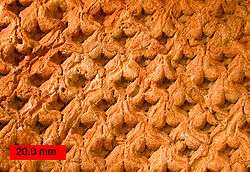Lepidodendron
| Lepidodendron Temporal range: Carboniferous | |
|---|---|
 | |
| The strobilus of Lepidodendron | |
| Scientific classification | |
| Kingdom: | Plantae |
| Division: | Lycopodiophyta |
| Class: | Isoetopsida |
| Order: | Lepidodendrales |
| Family: | Lepidodendraceae |
| Genus: | Lepidodendron |
| Species | |
|
See text | |
Lepidodendron — also known as scale tree — is an extinct genus of primitive, vascular, arborescent (tree-like) plant related to the lycopsids (club mosses). They were part of the coal forest flora. They sometimes reached heights of over 30 metres (100 ft), and the trunks were often over 1 m (3.3 ft) in diameter. They thrived during the Carboniferous Period (about 359.2 ± 2.5 Mya (million years ago) to about 299.0 ± 0.8 Mya) before going extinct.[1] Sometimes erroneously called "giant club mosses", they were actually more closely related to today's quillworts than to modern club mosses.
The name Lepidodendron comes from the Greek lepido, scale, and dendron, tree.
Description and biology

Lepidodendron had tall, thick trunks that rarely branched and were topped with a crown of bifurcating branches bearing clusters of leaves. These leaves were long and narrow, similar to large blades of grass, and were spirally-arranged. The vascular system was a siphonostele with exarch xylem maturation.
The closely packed diamond-shaped leaf scars left on the trunk and stems as the plant grew provide some of the most interesting and common fossils in Carboniferous shales and accompanying coal deposits. These fossils look much like tire tracks or alligator skin.



The scars, or leaf cushions, were composed of green photosynthetic tissue, evidenced by the cuticle covering and being dotted with stomata, microscopic pores through which carbon dioxide from the air diffuses into plants. Likewise, the trunks of Lepidodendron would have been green, unlike modern trees which have scaly, non-photosynthetic brown or gray bark.
Lepidodendron has been likened to a giant herb. The trunks produced little wood, being mostly soft tissues. Most structural support came from a thick, bark-like region. This region remained around the trunk as a rigid layer that grew thicker, but did not flake off like that of most modern trees. As the tree grew, the leaf cushions expanded to accommodate the increasing width of the trunk.
Lepidodendron likely lived in the wettest parts of the coal swamps that existed during the Carboniferous period. They grew in dense stands, likely having as many as 1000 to 2000 plants per hectare. This would have been possible because they did not branch until fully grown, and would have spent much of their lives as unbranched poles.
Reproduction
The branches of this plant ended in cone-structures. Lepidodendron did not produce true seeds like many modern plants. Instead, it reproduced by means of elaborate, encapsulated spores. It is estimated that these plants grew rapidly and lived 10–15 years. Most species were probably monocarpic, meaning they reproduced only once toward the end of their life.
Decline and extinction
By the Mesozoic era, the giant lycopsids had died out and were replaced by conifers as well as smaller Quillworts.[1] This may have been the result of competition from the emerging woody gymnosperms. Lepidodendron is one of the more common plant fossils found in Pennsylvanian (Late Carboniferous) age rocks. They are closely related to other extinct Lycopsid genera, Sigillaria and Lepidendropsis.
In popular culture
In the 19th century, due to the reptilian look of the diamond-shaped leaf scar pattern, petrified trunks of Lepidodendron were frequently exhibited at fairgrounds by amateurs as giant fossil lizards or snakes.
See also
References
- 1 2 Sahney, S., Benton, M.J. & Falcon-Lang, H.J. (2010). "Rainforest collapse triggered Pennsylvanian tetrapod diversification in Euramerica" (PDF). Geology. 38 (12): 1079–1082. doi:10.1130/G31182.1.
- Davis, Paul; Kenrick, Paul (2004). Fossil Plants. Washington, DC: Smithsonian Books. ISBN 1-58834-181-X.
- Morran, Robin C. (2004). A Natural History of Ferns. Portland: Timber Press. ISBN 0-88192-667-1.
- "Plant fossils of the British Coal Measures" by Christopher J.Cleal and Barry A.Thomas, publ. The Palaeontological Association, London, 1994, 222 pages, ISBN 0-901702-53-6.
| Wikimedia Commons has media related to Lepidodendron. |